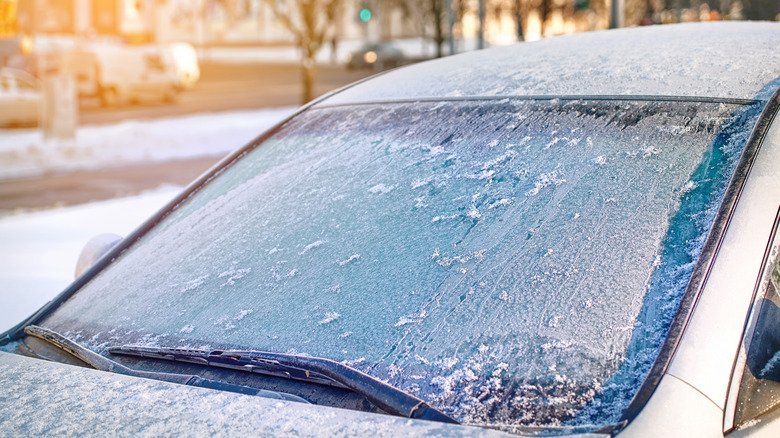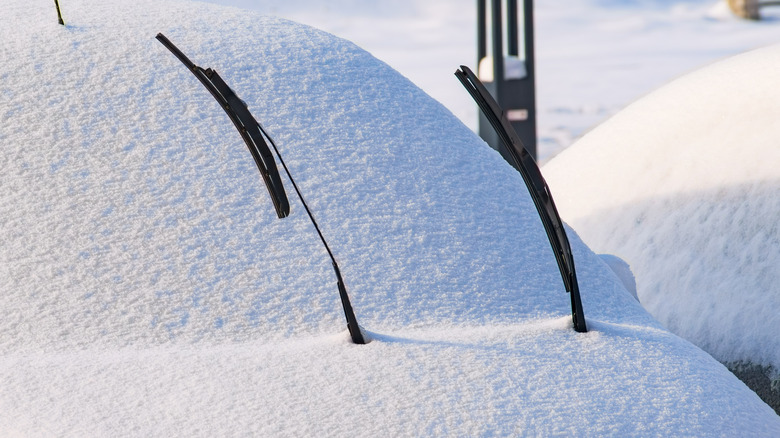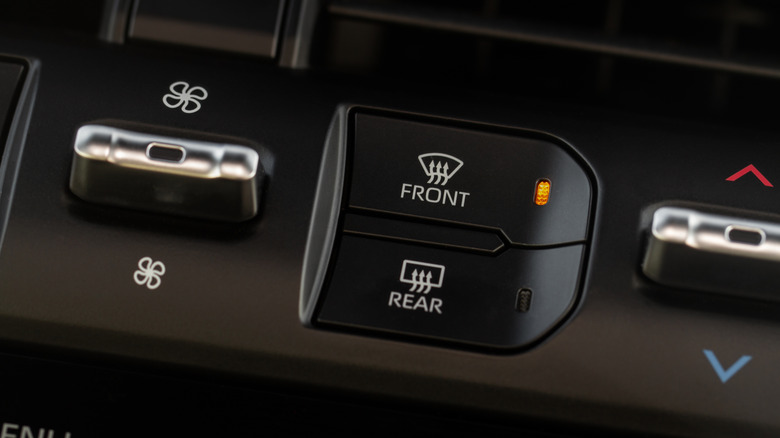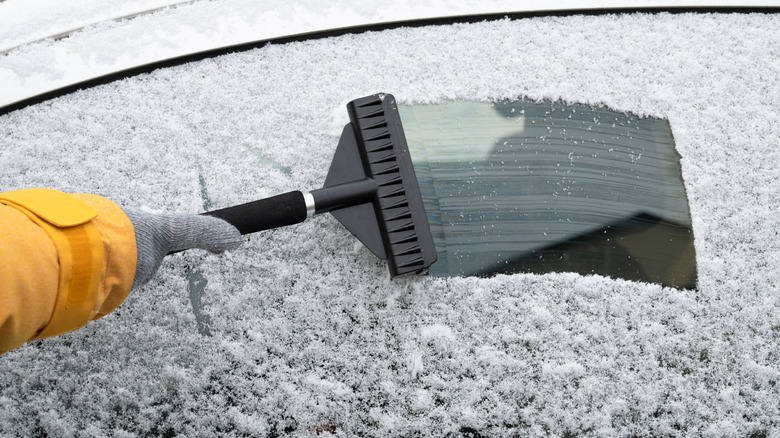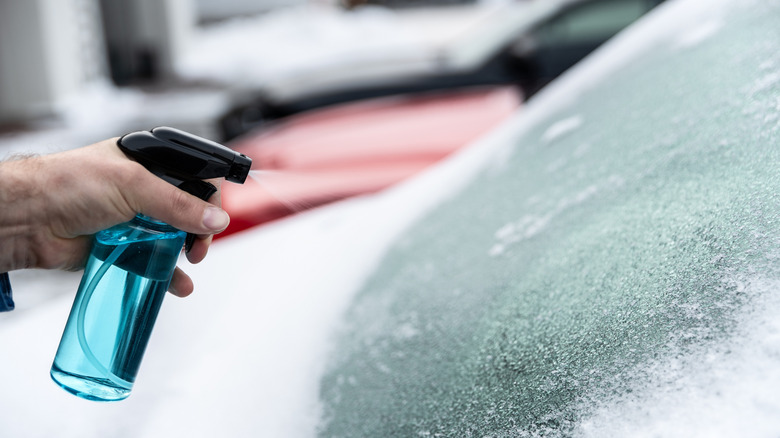How To Safely Defrost Your Car's Windshield During Winter
A frosty windshield can turn a winter morning into a frustrating challenge, especially when you're rushing to work or running errands. While a light dusting of snow is easy to handle, a solid sheet of ice on your windshield is a completely different story. The frost on the windshield accumulates when warm, moist air meets the cold surface of a car's windshield. This creates a condensation that freezes overnight. While clearing this ice is necessary for safe driving, improper methods — such as scraping aggressively or pouring hot water — can create more problems than they solve.
Rushing the defrosting process can risk cracking the windshield, leading to costly repairs. And if not done carefully, it could make your car a target for frost-jacking, which is when thieves take advantage of an idling vehicle left unattended during defrosting. Many drivers leave their cars running to warm up and melt the ice, which inadvertently makes the vehicle a target for car theft.
However, there are safer ways of defrosting your vehicle efficiently and quickly, without damaging the windshield or losing your car. With the right tools and a step-by-step approach, defrosting your windshield becomes a safe and easy part of your winter routine. These safer windshield defrosting techniques can make a huge difference on those cold winter mornings.
Check your wipers
Before you start your car, check the windshield wipers. Freezing temperatures can cause the rubber wipers to stick to the windshield. Activating the wipers while they are frozen can either tear the rubber or strain the motor that powers them. Damaged wipers won't properly perform their duties, and can smear ice or frost on your windshield, which will make driving hazardous. Or, if the motor is strained and has become nonfunctional, the wipers will not work at all. To prevent either of these scenarios, you should make sure the wipers are turned off before you start the car.
Carefully lift the wipers from the windshield to check if they're frozen. If they're stuck, resist the urge to forcefully pull them off the glass. Instead, gently pour lukewarm — not hot — water over the area of the frozen wipers to loosen the ice. You can also use a de-icer spray to safely release the wipers.
Start the engine and activate the defrosting features
To begin defrosting your windshield, start the engine to begin warming it up. If it's a diesel-powered vehicle, you may need to turn on the block heater first to heat the engine block and the frozen engine oil for a successful cold start. But you'll only need to turn on the heater if the temperatures reach below the 5 degrees Fahrenheit threshold. Once the engine is on, turn on the defroster, which clears the condensation from the windshield. You'll find the defroster button on the dashboard. It has the window symbol with three slightly curved arrows pointing upwards. While this normally takes care of the windshield, there are ways you could speed up the process.
While it may seem counter-intuitive, turning on the air-conditioner helps as well. It removes moisture from inside your car, which reduces the condensation on the glass. But, make sure to turn off the air recirculation mode — the button with a car symbol with a U-turn arrow inside — to avoid having the air within the vehicle redirected back to the AC. Crack your windows slightly to allow the colder and drier air to flow in, which will balance the humidity levels and speed up defrosting.
As the car warms up, the ice on the windshield will begin to melt. Even as you see it melt away, avoid scraping it off prematurely. Give the ice time to loosen the ice for easier removal. The amount of time will depend on the conditions and the thickness of the ice. Never leave your car unattended while it's running, as this could pose security risks. Stay nearby and use this time to scrape off snow and ice from other parts of the vehicle, like the roof, headlights, and mirrors.
Use an ice scraper, brush, and squeegee
Once the heat has softened the ice, it's time to take action with the right tools. Start with a plastic ice scraper designed for automotive use. To remove the loosened ice, gently scrape the windshield from top to bottom. You should avoid metal scrapers as they can scratch the glass and damage the wiper blades.
If there's still snow or slush on your windshield, use a soft-bristled brush to sweep it off. Make sure you're thorough, as clearing the all debris gives you an unobstructed view when driving. Follow up with a rubber squeegee to remove any excess water left on the windshield, which prevents the melted from refreezing.
Besides the windshield, take care of the frost on other parts of your car, like the headlights, taillights, and mirrors, as neglecting these areas could compromise your safety. To top that off, always handle the tools gently to avoid putting pressure on the windshield glass.
Use a windshield de-Icer spray
A windshield de-icer spray is one of the fastest and most efficient ways of defrosting your car. These sprays are designed to break down ice quickly to save time on frosty mornings. To use, simply spray the de-icer evenly across the frozen windshield and wait for it to penetrate the ice. Once the ice has softened, you can then use the ice scraper to remove the ice.
For best results, consider following the manufacturer's instructions placed on the de-icer label. Overusing the de-icer is unnecessary and could lead to streaks or buildup on the car's windshield. You should clear any residual to maintain a clear view of the road.
If you prefer a DIY option, you can create your custom de-icer solution. Mix two parts of 70% isopropyl alcohol with one part of water, plus a small amount of dish soap. This mixture lowers the freezing point and can be sprayed directly onto the windshield. However, be mindful of the effects this could have on the coating, and regularly wash and wax the car. It's also one of the ways to protect your car from rust, which is typical of cars in colder climates.
